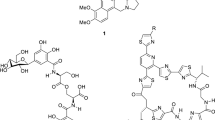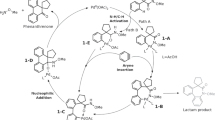Abstract
A new method for the syn-dichlorination of alkenes at room temperature has been proposed by Denmark et al. The method uses diselenide (PhSeSePh) as the precatalyst, benzyltriethylammonium chloride (BnEt3NCl) as the source of chlorine, and an N-fluoropyridinium salt as the oxidant to recover the catalyst. This approach has achieved exquisite diastereocontrol on a number of alkene substrates. In this paper, we report the results of DFT calculations we performed to study the mechanism of this reaction. We were able to identify a reasonable reaction path, including the intermediate and transition-state structures. The results also indicate that PhSeCl3, rather than PhSeCl, is the active catalyst.






Similar content being viewed by others
References
Cresswell AJ, Eey ST-C, Denmark SE (2015) Catalytic, stereospecific syn-dichlorination of alkenes. Nat Chem 7:146–152
Kladi M, Vagias C, Roussis V (2004) Volatile halogenated metabolites from marine red algae. Phytochem Rev 3:337–366
Nicolaou K, Simmons NL, Ying Y, Heretsch PM, Chen JS (2011) Enantioselective dichlorination of allylic alcohols. J Am Chem Soc 133:8134–8137
Cresswell AJ, Eey STC, Denmark SE (2015) Catalytic, stereoselective dihalogenation of alkenes: challenges and opportunities. Angew Chem Int Ed 54:15642–15682
Wirth T (2000) Organoselenium chemistry: modern developments in organic synthesis. Springer, Berlin
Wirth T (2012) Organoselenium chemistry: synthesis and reactions. Wiley-VCH, Weinheim
Freudendahl DM, Santoro S, Shahzad SA, Santi C, Wirth T (2009) Green chemistry with selenium reagents: development of efficient catalytic reactions. Angew Chem Int Ed 48:8409–8411
Santi C, Santoro S, Battistelli B (2010) Organoselenium compounds as catalysts in nature and laboratory. Curr Org Chem 14:2442–2462
Santoro S, Azeredo JB, Nascimento V, Sancineto L, Braga AL, Santi C (2014) The green side of the moon: ecofriendly aspects of organoselenium chemistry. RSC Adv 4:31521–31535
Yu L, Ye J, Zhang X, Ding Y, Xu Q (2015) Recyclable (PhSe)2-catalyzed selective oxidation of isatin by H2O2: a practical and waste-free access to isatoic anhydride under mild and neutral conditions. Catal Sci Technol 5:4830–4838
Guo R, Huang J, Huang H, Zhao X (2016) Organoselenium-catalyzed synthesis of oxygen- and nitrogen-containing heterocycles. Org Lett 18:504–507
Tay DW, Tsoi IT, Er JC, Leung GYC, Yeung Y-Y (2013) Lewis basic selenium catalyzed chloroamidation of olefins using nitriles as the nucleophiles. Org Lett 15:1310–1313
Zeng X, Gong C, Zhang J, Xie J (2016) Organoselenium-catalyzed vicinal dichlorination of unsaturated phosphonates. New J Chem 40:7866–7871
Santi C, Di Lorenzo R, Tidei C, Bagnoli L, Wirth T (2012) Stereoselective selenium catalyzed dihydroxylation and hydroxymethoxylation of alkenes. Tetrahedron 68:10530–10535
Mellegaard SR, Tunge JA (2004) Selenium-catalyzed halolactonization: nucleophilic activation of electrophilic halogenating reagents. J Org Chem 69:8979–8981
Carrera I, Brovetto MC, Seoane GA (2006) Selenium-catalyzed iodohydrin formation from alkenes. Tetrahedron Lett 47:7849–7852
Trenner J, Depken C, Weber T, Breder A (2013) Direct oxidative allylic and vinylic amination of alkenes through selenium catalysis. Angew Chem Int Ed 52:8952–8956
Deng Z, Wei J, Liao L, Huang H, Zhao X (2015) Organoselenium-catalyzed, hydroxy-controlled regio-and stereoselective amination of terminal alkenes: efficient synthesis of 3-amino allylic alcohols. Org Lett 17:1834–1837
Denmark SE, Collins WR (2007) Lewis base activation of Lewis acids: development of a Lewis base catalyzed selenolactonization. Org Lett 9:3801–3804
Divac VM, Puchta R, Bugarčić ZM (2012) Kinetic and mechanistic studies of base-catalyzed phenylselenoetherification of (Z)-and (E)-hex-4-en-1-ols. J Phys Chem. A 116:7783–7790
Rvovic MD, Divac VM, Puchta R, Bugarčić ZM (2011) Mechanistic investigation of the base-promoted cycloselenoetherification of pent-4-en-1-ol. J Mol Model 17:1251–1257
Janković N, Marković S, Bugarčić Z (2014) DFT study of the mechanism of the phenylselenoetherification reaction of linalool. Monatsh Chem 145:1287–1296
Kostić MD, Divac VM, Puchta R, Bugarčić ZM (2015) Kinetic and mechanistic insight into Lewis base and acid-mediated phenylselenoetherification of 2,6-dimethyl-hept-5-en-2-ol. Struct Chem 26:915–922
Marković S, Janković N, Bugarčić Z (2015) Influence of the counteranion on the phenylselenoetherification reaction of nerolidol. Monatsh Chem 146:275–282
Bugarčić ZM, Petrović BV, Rvović MD (2008) Kinetics and mechanism of the pyridine-catalyzed reaction of phenylselenenyl halides and some unsaturated alcohols. J Mol Catal A 287:171–175
Frisch M, Trucks G, Schlegel H, et al. (2010) Gaussian 09, revision B.01. Gaussian Inc., Wallingford
Hohenberg P, Kohn W (1964) Inhomogeneous electron gas. Phys Rev 136:B864
Becke AD (1988) Density-functional exchange-energy approximation with correct asymptotic behavior. Phys Rev A 38:3098
Becke AD (1993) Becke’s three parameter hybrid method using the LYP correlation functional. J Chem Phys 98:5648–5652
Frisch MJ, Pople JA, Binkley JS (1984) Self-consistent molecular orbital methods 25. Supplementary functions for Gaussian basis sets. J Chem Phys 80:3265–3269
Barone V, Cossi M (1998) Quantum calculation of molecular energies and energy gradients in solution by a conductor solvent model. J Phys Chem A 102:1995–2001
Barone V, Cossi M, Tomasi J (1998) Geometry optimization of molecular structures in solution by the polarizable continuum model. J Comput Chem 19:404–417
Fukui K (1981) The path of chemical reactions—the IRC approach. Acc Chem Res 14:363–368
Grimme S (2014) DFT-D3 program. Mulliken Center for Theoretical Chemistry, Bonn
Grimme S, Antony J, Ehrlich S, Krieg H (2010) A consistent and accurate ab initio parametrization of density functional dispersion correction (DFT-D) for the 94 elements H–Pu. J Chem Phys 132:154104
Grimme S, Ehrlich S, Goerigk L (2011) Effect of the damping function in dispersion corrected density functional theory. J Comput Chem 32:1456–1465
Foster J, Weinhold F (1980) Natural hybrid orbitals. J Am Chem Soc 102:7211–7218
Reed AE, Weinhold F (1983) Natural bond orbital analysis of near-Hartree–Fock water dimer. J Chem Phys 78:4066–4073
Weinhold F (1998) Natural bond orbital methods. In: Schleyer PvR, Allinger NL, Clark T, et al. (eds) Encyclopedia of computational chemistry, vol 3. Wiley, Chichester
Acknowledgments
We would like to thank the National Natural Science Foundation for financial support.
Author information
Authors and Affiliations
Corresponding author
Electronic supplementary material
ESM 1
(DOCX 46 kb)
Rights and permissions
About this article
Cite this article
Fu, L., Mu, X. & Li, B. Reaction mechanism of organoselenium-catalyzed syn-dichlorination of alkenes: a DFT study. J Mol Model 24, 91 (2018). https://doi.org/10.1007/s00894-018-3624-9
Received:
Accepted:
Published:
DOI: https://doi.org/10.1007/s00894-018-3624-9




